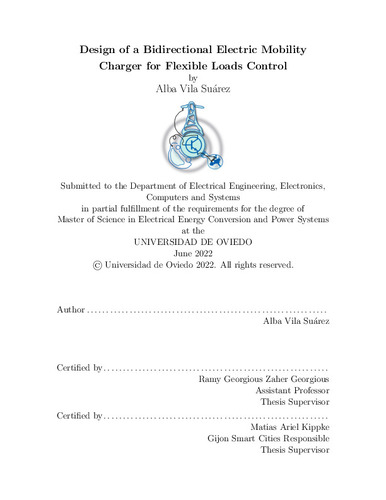Design of a bidirectional electric mobility charger for flexible loads control
Otros títulos:
Diseño de cargador bidireccional de movilidad eléctrica para cargas flexibles
Autor(es) y otros:
Director(es):
Fecha de publicación:
Serie:
Máster Universitario en Conversión de Energía Eléctrica y Sistemas de Potencia
Descripción física:
Resumen:
This thesis presents the design and control of a bidirectional electric vehicle charger for flexible loads control. The objective of this kind of control is to model a system that allows certain loads to inject power to the grid and contribute to stabilized and support the system. As there is power conversion, this involves the study of two different converters, one for AC-DC and one for DC-DC conversion. The topologies selected are a single-phase rectifier with Power Factor Correction (PFC) and a flyback converter. The dynamic behaviour is analyzed for both converters by obtaining the average model for both converter and the small-signal model for the flyback converter. Then, a control strategy is proposed accordingly to the studied behaviours. The equivalent first order model is also studied, and an algorithm control to preserve the battery life is implemented. A series of test are compiled, including the correct response for the different scenarios that might be presented. The tool selected to perform this tests is Simulink MATLAB®.
This thesis presents the design and control of a bidirectional electric vehicle charger for flexible loads control. The objective of this kind of control is to model a system that allows certain loads to inject power to the grid and contribute to stabilized and support the system. As there is power conversion, this involves the study of two different converters, one for AC-DC and one for DC-DC conversion. The topologies selected are a single-phase rectifier with Power Factor Correction (PFC) and a flyback converter. The dynamic behaviour is analyzed for both converters by obtaining the average model for both converter and the small-signal model for the flyback converter. Then, a control strategy is proposed accordingly to the studied behaviours. The equivalent first order model is also studied, and an algorithm control to preserve the battery life is implemented. A series of test are compiled, including the correct response for the different scenarios that might be presented. The tool selected to perform this tests is Simulink MATLAB®.
Colecciones
- Trabajos Fin de Máster [5292]
Ficheros en el ítem





